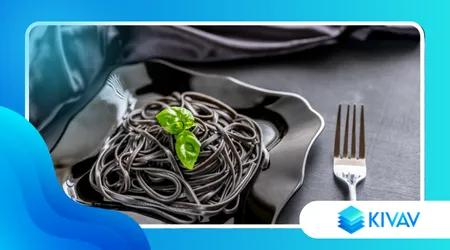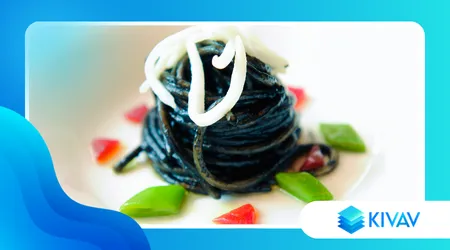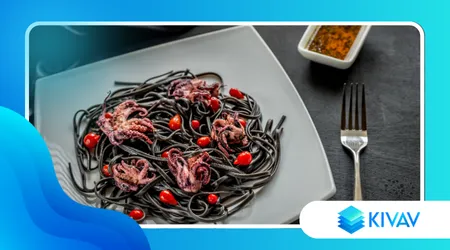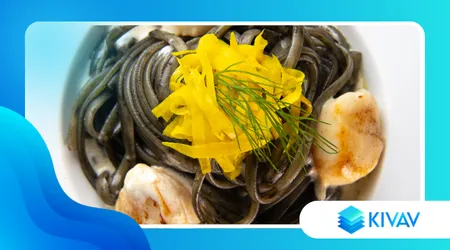Linguine with Cuttlefish Ink
Squid Ink Linguine: Imagine a dish that captures the eye with its intense black color, a visual mystery that promises an explosion of marine flavors.
Announcements
The linguine with cuttlefish ink It is not just a dish, but a sensory experience that combines tradition, boldness and refinement.
Originating from the Italian coasts, particularly Sicily and Campania, this dish pays homage to the sea, combining the simplicity of pasta with an ingredient as unique as it is fascinating: squid ink.
But what makes this dish so special? Is it just an aesthetic trend, or is there more behind that velvety black?
The Dark Charm of Cuttlefish Ink Linguine

The answer lies in its history and its versatility.
Announcements
Squid ink linguine is a symbol of Italian coastal cuisine, where fresh ingredients and traditional techniques blend to create unforgettable flavors.
The squid ink, far from being a simple colorant, gives the dish a salty, umami note that elevates every bite.
++ Cold Italian Pasta for Summer
Furthermore, its popularity is growing: according to a 2024 Coldiretti report, the consumption of fish-based dishes in Italy has increased by 12% in the last five years, with linguine with squid ink among the protagonists of this trend.
In this article, we'll explore the world of squid ink linguine, from its cultural origins to its preparation techniques, its nutritional benefits, and the curiosities that make it unique.
Get ready to discover original recipes, practical tips, and answers to frequently asked questions, all accompanied by an analogy that will make you see this dish in a new light.
Cultural Origins: A Heritage of the Sea

Cuttlefish ink linguine has its roots in the maritime traditions of the Mediterranean, particularly in the coastal regions of Southern Italy.
In Sicily, for example, cuttlefish ink has been used for centuries not only in cooking, but also as a traditional remedy for its anti-inflammatory properties.
++ Spaghetti alla Puttanesca: Traditional Recipe
This dish, however, is not just a product of necessity, but an expression of the creativity of the fishermen, who transformed every part of the cuttlefish into a work of culinary art.
The choice of linguine, with its long, flat shape, is no coincidence: its texture holds the sauce perfectly, creating a balance between pasta and sauce.
Unlike other seafood dishes, linguine with squid ink stands out for its dramatic appearance, reminiscent of the deep sea.
It's as if each dish were a canvas on which the chef paints with the flavors of the Mediterranean, an analogy that reminds us that cooking is an art form.
In regions like Venice, the dish is often enriched with local seafood, while in Campania a simpler version is preferred, with fresh cherry tomatoes to balance the richness of the ink.
This regional variety demonstrates the dish's versatility, capable of adapting to local tastes without losing its essence.
But why has squid ink linguine become such an icon?
Perhaps because it represents a bridge between past and present, between the humble cuisine of fishermen and modern haute cuisine.
Today, Michelin-starred chefs reinterpret it with innovative touches, such as the addition of citrus fruits or exotic spices, while Italian families continue to prepare it following recipes passed down for generations.
This duality makes it a timeless dish, capable of speaking to everyone.
How to Make Squid Ink Linguine: Techniques and Secrets

Making perfect squid ink linguine requires attention to detail and a pinch of patience.
The key is the freshness of the ingredients: the cuttlefish must be of excellent quality, and the ink, if possible, extracted directly from the mollusc.
However, for those who don't have access to fresh cuttlefish, ink sachets are a practical and equally valid alternative.
++ Pasta alla Gricia: The Mother of Carbonara
The first step is to clean the cuttlefish, carefully removing the ink sac to avoid breaking it. This process, though laborious, is essential to achieving an authentic flavor.
Once the ingredients are ready, making the sauce is an art in itself.
Sauté the garlic and onion in extra virgin olive oil, then add the chopped cuttlefish.
After a few minutes, deglaze with white wine and add the ink, diluted with a little fish stock or pasta cooking water.
The sauce must cook over low heat to blend the flavors, but without losing its intensity.
For the linguine, cook it al dente and sauté it in the sauce to ensure every strand of pasta is coated in the sauce.
A touch of fresh parsley or lemon zest can add a note of freshness.
Here is a table with the recommended times and quantities for impeccable preparation:
| Ingredient | Quantity for 4 people | Preparation time |
|---|---|---|
| Linguine | 320 g | 8-10 minutes (cooking) |
| Fresh cuttlefish | 600 g | 15 minutes (cleaning) |
| Cuttlefish ink | 8-10 g (2-3 bags) | 5 minutes (extraction) |
| Extra virgin olive oil | 4 tablespoons | – |
| White wine | 100 ml | – |
To avoid common mistakes, don't overdo the ink: too much can make the dish too intense.
Also, use a large pan to sauté the pasta, so that the sauce is evenly distributed.
With these tips, your squid ink linguine will be a triumph of taste and presentation.
Two Original Recipes to Surprise

Recipe 1: Squid Ink Linguine with Orange Zest and Pistachios
For those who want a touch of modernity, this version combines the umami of the ink with the freshness of the orange and the crunchiness of the pistachios.
Start by preparing a classic sauce with cuttlefish, garlic, oil, and ink, but add a teaspoon of grated orange zest in the last few minutes of cooking.
This ingredient adds a citrus note that balances the richness of the dish.
After tossing the linguine in the sauce, finish with a sprinkling of coarsely chopped pistachios, which add texture and a lightly toasted flavor.
This recipe is perfect for an elegant dinner, where the contrast between the black of the pasta and the green of the pistachios creates a stunning visual effect.
Serve the dish with a dry white wine, such as a Vermentino, to enhance the flavors.
The orange zest, in particular, acts like a ray of sunshine illuminating the deep sea of the dish, making every bite a memorable experience.
Recipe 2: Squid Ink Linguine with Confit Cherry Tomatoes and Bottarga
For a tribute to Sicilian tradition, try this variation that combines the sweetness of confit cherry tomatoes with the savory flavor of bottarga.
Prepare the cherry tomatoes by cooking them slowly in the oven at 120°C with oil, garlic, thyme and a pinch of sugar for an hour.
Meanwhile, make the cuttlefish ink sauce, adding the confit tomatoes at the end of cooking so as not to alter its consistency.
After sautéing the linguine, grate a little mullet bottarga over the dish for a burst of seafood flavor.
This version is a perfect balance between sweetness, saltiness and umami, ideal for those who love contrasts.
The bottarga adds a touch of luxury without complicating the preparation, while the confit cherry tomatoes bring a sweetness that tones down the intensity of the ink.
It's a dish that tells a story of sea and land, perfect for a dinner with family or friends.
Nutritional Benefits and Curiosities
Nutritionally, squid ink linguine is a surprisingly balanced dish.
Cuttlefish is rich in lean protein, B vitamins, and minerals such as selenium and iron, which are essential for the nervous system and blood health.
Cuttlefish ink also contains antioxidants and anti-inflammatory compounds, as demonstrated by studies published in Marine Drugs (2023), which highlight its potential benefits for cardiovascular health.
While the dish may seem indulgent, an average 100g portion of cuttlefish provides only about 80 kcal, making it suitable for a balanced diet.
A curious aspect is that squid ink is not just a culinary ingredient.
In the past, it was used as ink for writing and painting, thanks to its intense black tone and its stability.
Even today, some artists use it in works of art, demonstrating the versatility of this ingredient.
Additionally, in Japan, squid ink is used in dishes such as black sushi, highlighting how different cultures have found unique ways to enhance it.
But let's get back to the question: why choose squid ink linguine over other seafood dishes?
The answer lies in its ability to surprise and delight, combining taste, aesthetics, and history in a single experience.
It's a dish that not only nourishes the body, but also stimulates the mind and imagination, inviting you to explore the sea in every bite.
Frequently Asked Questions: Answers to Common Questions
| Request | Answer |
|---|---|
| Is squid ink safe to eat? | Absolutely, if it comes from fresh cuttlefish or quality sachets. It's a natural ingredient rich in antioxidants. |
| Can I use pasta other than linguine? | Sure, but linguine is ideal for its ability to hold the sauce. Spaghetti or tagliatelle are good alternatives. |
| How to avoid the sauce becoming too intense? | Use ink sparingly and balance it with fresh ingredients like lemon or cherry tomatoes. |
| How long does the dish keep? | It's best consumed fresh, but the sauce can be stored in the refrigerator for 1-2 days. Reheat carefully to avoid altering the flavors. |
| Can I prepare this dish without fresh cuttlefish? | Yes, ink sachets are a practical solution, but choose high-quality products for an authentic taste. |
Conclusion: A Dish That Tells a Story
Squid ink linguine is much more than just a simple pasta dish.
It's a journey along the Italian coast, a tribute to tradition and an invitation to experiment with bold flavors.
Whether you prepare it classic or with a creative twist, this dish has the power to transform a dinner into an unforgettable experience.
With its deep roots in maritime culture and its ability to adapt to modern tastes, linguine with squid ink is a perfect example of how cuisine can be art, history, and pleasure in a single dish.
So, are you ready to dive into this sea of flavors?
The next time you want to surprise your guests or simply treat yourself to a unique dish, let squid ink linguine take center stage at your table.
Enjoy your meal!
